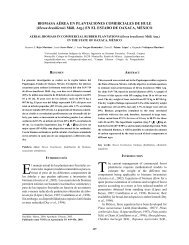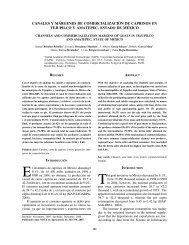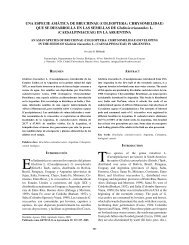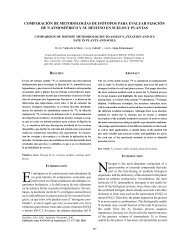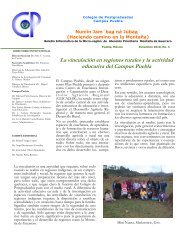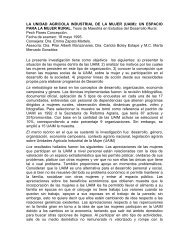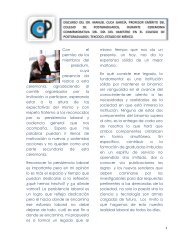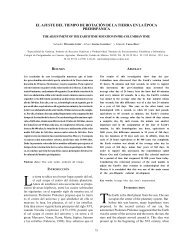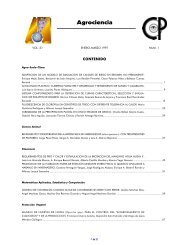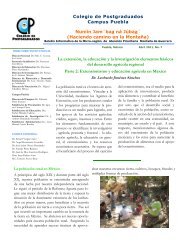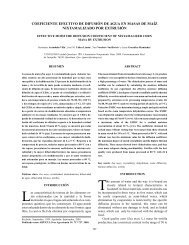AUTO-ACLAREO Y GUÍAS DE DENSIDAD PARA Pinus patula ...
AUTO-ACLAREO Y GUÍAS DE DENSIDAD PARA Pinus patula ...
AUTO-ACLAREO Y GUÍAS DE DENSIDAD PARA Pinus patula ...
You also want an ePaper? Increase the reach of your titles
YUMPU automatically turns print PDFs into web optimized ePapers that Google loves.
<strong>AUTO</strong>-<strong>ACLAREO</strong> Y <strong>GUÍAS</strong> <strong>DE</strong> <strong>DE</strong>NSIDAD <strong>PARA</strong> <strong>Pinus</strong> <strong>patula</strong> MEDIANTE EL ENFOQUE <strong>DE</strong> REGRESIÓN <strong>DE</strong> FRONTERA ESTOCÁSTICA<br />
Figura 3. Líneas de mortalidad de parcelas permanentes de <strong>Pinus</strong> <strong>patula</strong> usadas para delimitar las<br />
zonas de crecimiento en las guías de densidad.<br />
Figure 3. Mortality lines of <strong>Pinus</strong> <strong>patula</strong> permanent plots used to identify the growth areas in the<br />
density management diagrams.<br />
Smith et al., 1997), en las cuales debe planificarse el<br />
manejo de la densidad de un rodal para maximizar el<br />
crecimiento individual o para maximizar la producción<br />
de biomasa total.<br />
La mortalidad se presenta aproximadamente<br />
desde 55 % del IDR y al acercarse los rodales hacia<br />
el IDR máximo (100 %), la mortandad es más<br />
pronunciada por efecto de la competencia por los<br />
recursos del sitio. En este estudio, 55 % del IDR<br />
puede establecerse como el límite inferior de la<br />
zona de mortalidad inminente o auto-aclareo (55-<br />
100 % del IDR). En esta zona se considera que el<br />
crecimiento por árbol y por hectárea disminuye a<br />
medida que aumenta la competencia. Estos resultados<br />
concuerdan con otros estudios que definen el<br />
límite inferior del auto-aclareo entre 55 a 60 % de<br />
la densidad máxima: 55 % del IDR máximo para P.<br />
menziesii (Drew y Flewelling, 1979), 55 a 60 % del<br />
IDR máximo para rodales de <strong>Pinus</strong> ponderosa Laws.<br />
(Long y Shaw, 2005), 60 % para <strong>Pinus</strong> sylvestris L.<br />
(Vacchiano et al., 2008) y para rodales de N. alpina,<br />
N. dombeyi y N. obliqua (Gezan et al., 2007).<br />
De 30 a 55 % de IDR el análisis de los datos<br />
sugiere la zona de crecimiento constante y este intervalo<br />
se puede considerar como el nivel donde<br />
existe ocupación plena del sitio, consecuentemente<br />
es donde se maximiza el crecimiento bruto del<br />
rodal. De acuerdo con los registros de las parcelas<br />
permanentes, se establecieron estos niveles como<br />
la zona de máximo crecimiento en la guía de densidad<br />
(30-55 % del IDR máximo). Este intervalo<br />
es consistente con el 35-55 % del IDR máximo en<br />
canopy closure occurs. According to Gezan et al.<br />
(2007), to define this line, a maximum canopy area<br />
ratio is used, which is used afterwards to determine<br />
the maximum number of free growing trees that a<br />
stand could tolerate. Unfortunately there are no data<br />
of trees growing free of competition and therefore<br />
in this case, it is not possible to generate the line in<br />
which <strong>Pinus</strong> <strong>patula</strong> canopy closing occurs. However,<br />
setting it at 20 % of SDI as an approximation is<br />
reasonable, according to other studies in conifers.<br />
Drew and Flewelling (1979) set this line at 15 % for<br />
P. menziesii, and according to Long and Shaw (2005)<br />
and Vacchiano et al. (2008), this line is 25 % of SDI<br />
for P. ponderosa and P. sylvestris.<br />
The density diagram based on YDI shows the<br />
Langsaeter ratios. The 100 % line indicates the<br />
maximum possible density or upper limit of selfthinning;<br />
the 55 % line defines the lower limit of<br />
the self-thinning area; the 30 % line corresponds<br />
to the lower limit of the zone of constant growth<br />
and the 20 % line represents the upper limit of free<br />
growth without mortality. Figure 4 shows the density<br />
diagrams obtained from the best fittings of SFR.<br />
conclusIons<br />
The method of stochastic frontier regression<br />
provides an alternative for efficiently estimating<br />
the upper limit of self-thinning, being consistent<br />
with the theory on maximum density populations.<br />
One advantage is to be able to greatly expand the<br />
amount of useful data for the construction of density<br />
SANTIAGO-GARCÍA et al.<br />
87



